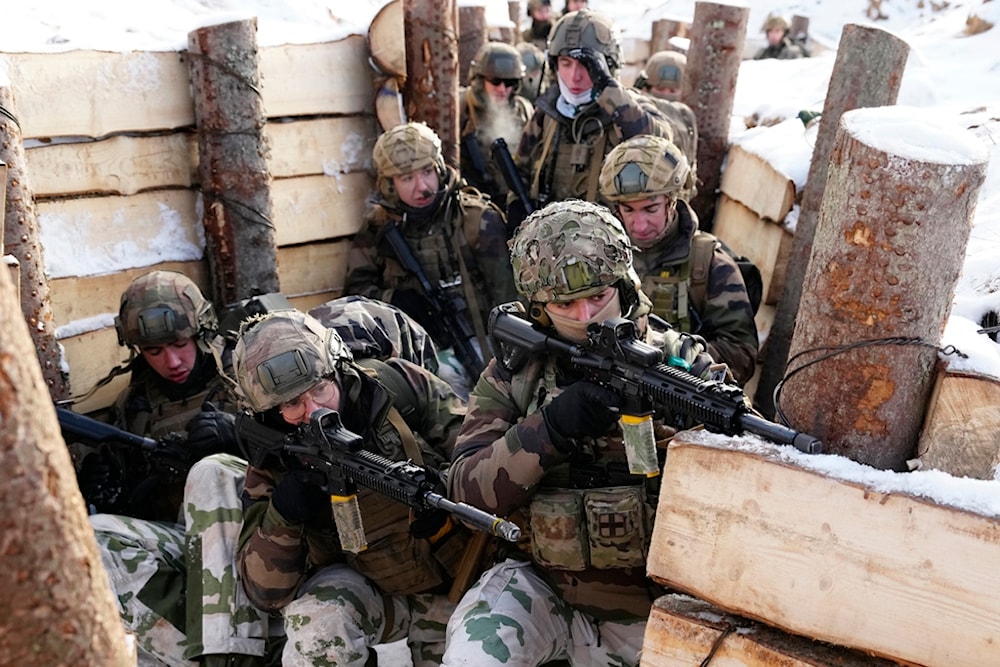Global military spending on the rise, new record highs expected
The annualy "Military Balance" report by International Institute for Strategic Studies cites the world increase in military budgets to increased conflict zones across the globe.
-

French soldiers attend the Winter Camp 23 military drills near Tapa, Estonia, Sunday, Feb. 5, 2023 (AP Photo/Pavel Golovkin, File)
As global tensions rise, military spending in 2023 hit a record high of $2.2 trillion, soaring 9% from the previous year, and is expected to cross this mark in 2024, the International Institute for Strategic Studies IISS said in its “Military Balance” report released Tuesday.
IISS Director General Bastian Giegerich told reporters in London that a series of factors indicated “a picture of strategic instability and a new era of contested power.” In his remarks, he pointed out the ongoing war between Russia and Ukraine, China's growing military prowess, coups in African countries and the current Middle East escalations.
Read more: 'Israel' to increase military spending: Bloomberg
In its 65th annual publication, it also pointed out the extensive destruction caused by ongoing conflicts, including that between Russia and Ukraine. This has forced Moscow to utilize older military vehicles after field losses of hardware, it claimed.
Meanwhile, NATO's defense spending surpassed 50% of the world total, despite the coalition's member states only being one-eighth of the global population.
The report noted that rising military spending "coincide with repeated remarks by former president Donald Trump on the levels of U.S. allies’ defense spending."
Trump has repeatedly slammed NATO members for not meeting the spending target of 2% of their GDPs, while the United States is carrying most of the burden, as he claims.
Last week, talking to supporters at a campaign rally, the leading presidential candidate said that, in case he won office, he would approve that Moscow does whatever the hell they want” to NATO states who lacked their spending commitment.
“You didn’t pay. You’re delinquent,” Trump claimed to have told a foreign leader during his presidency.
Europe faces hard reality
However, the IISS report showed that, collectively, Washington's NATO allies have hiked their defense spending by 32% since 2014, mostly since 2022 - after the start of the war in Ukraine.
Last year, ten European Union member states fulfilled the goal of dedicating 2 percent of their GDP to defense, marking an increase from eight countries the year before. The IISS also noted that all European NATO states met the requirement of allocating 20 percent of their defense expenditures to equipment.
Read more: NATO provided Ukraine with over $70bln in military aid: Chief
But coalition members refused last year to make a pledge to ensure a military budget of over the current mark.
Some countries, most notably Germany, are still far from reaching the 2% of GDP target, despite declaring long-term plans to increase military spending. France had also made the same announcement earlier.
Economic crises and inflation have negated the effects of some increases in military spending of NATO members, the report said, meanwhile, demands for arms have increased, revealing a reality that “European arms production was not geared for wartime.”
Washington remains unrivaled in military spending
The United States continues to claim the number one spot for military spending, having passed a $900 billion budget in 2023 - more than the next 15 countries on the list combined. However, the budget vs GDP was 3.36%; less than in earlier years, ISS said, noting that this comes despite its massive funds to Ukraine.
“This compares to defense spending in the Cold War that was reaching 8 percent on a much smaller GDP,” Dana Allin, a fellow with IISS, said. “So obviously this isn’t much of a strain for the United States.”
While the West is spending more on military budgets, so are Russia and China. And with lower costs and heavy state involvement in the defense industry, they often appear to be getting more for their money.
Western countries are not the only ones upping their military budgets Russia and China are doing the same, the report noted. However, both countries have the advantage of lower costs and "heavy state involvement in the defense industry, they often appear to be getting more for their money."
Since the start of the conflict in Ukraine, Moscow increased its military expenditure by around 30% in 2023; an estimated 7.5% of the country's GDP at around $108 billion - over three times that of Ukraine sitting at $31 billion.
According to the IISS, there has been a continuous rise in China's defense spending for the 29th year in a row. However, the amount remained under 2% of GDP, while the country is working to modernize its military program to create a “world-class” military less reliant on foreign technologies by 2050.
Taiwan announced last year a $19 billion defense budget - the largest in the island's history. The new fund represents around 2.6% of its GDP. Japan and Seoul have also increased their spending.

 5 Min Read
5 Min Read








